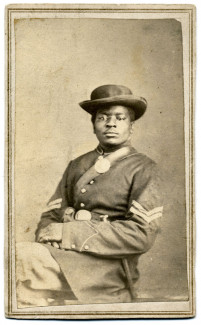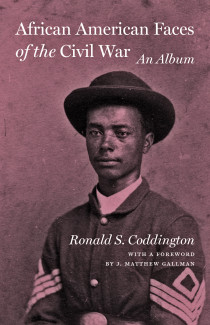
Johns Hopkins UniversityEst. 1876
America’s First Research University
Unearthing rare images and unique stories of African American Civil War soldiers
Guest post by Ronald S. Coddington
After my second book, Faces of the Confederacy, debuted in 2008, colleagues and friends asked me about my next project. I answered that African American soldiers would be the focus of my next volume.
My reply was met with a healthy dose of skepticism.
Two bits of conventional wisdom surfaced in their comments. First, that finding enough wartime photographs of identified soldiers would prove impossible. Second, that the stories of African American soldiers are uninteresting because so few fought in battles.

Despite the skepticism of my peers, I remained convinced that a wealth of visual and textual material was waiting to be discovered.
I started with photographs. Online searches resulted in a handful of images in university collections, historical societies, and museums. Contact with private collectors and Civil War dealers turned up a few promising leads.
Next, I scouted out primary sources of information. One of the first places I looked was William F. Fox’s landmark 1889 treatise Regimental Losses in the American Civil War. The chapter dedicated to “colored troops” is a condensed history of the origins of 166 African American regiments and a list of more than 35 battles in which they participated.
Through Regimental Losses and other texts, I realized that my perceptions of the Civil War had been shaped from a white point of view: The Northern populace initially went to war to preserve the Union, and after President Abraham Lincoln issued the Emancipation Proclamation in 1863, the central aim of the war shifted to the abolition of slavery.
Considered from the African American perspective, the war had been about freedom from the beginning. The brave black men who fought for equality were central to the greatest chapter in American history.
The trek to unearth images
My longtime passion for vernacular photography of the Civil War era caused me to instinctively turn to the vibrant community of collectors and dealers at relic shows along the East coast and as far west as Ohio. Through their generosity, I secured about a third of the images featured in the book.

The remainder came in groups of ones and twos, tucked away in archives across the country. I also found several larger caches, including a collection in the Beinecke Rare Book and Manuscript Library at Yale University.
Over a two-year period I secured permission to reproduce 95 identified images. I selected 77 for inclusion in the book, the same number featured in my other volumes.
The search for transformative stories of the war
My research effort began online by submitting queries to Ancestry.com and the military research forum at AfriGeneas.com. I searched digital books and finding aids of collections owned by public and private institutions, and subscribed to several databases of military service files, genealogical records, and newspapers.
Much to my delight, I discovered a digital collection of African American newspapers on Accessible Archives. These provided a wealth of detail on military, political, economic, and social issues. I found other rare interviews and eyewitness battle accounts on the newspaper archive NewsinHistory.com.
I gathered additional information during trips to the National Archives in Washington, D.C., and visits to other archives, libraries, and museums. My local interlibrary loan program was indispensable. I also communicated with descendants by email and telephone.
The entire project, from concept to publication, required four years—the same length of time it took to fight the Civil War.



